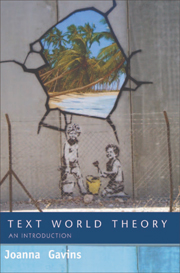1 - Conceptualising Language
Published online by Cambridge University Press: 05 August 2013
Summary
Old cockerel seeks hen to scratch around new pastures. Ex-farmer, 57, seeks lady, 45–55, without ties to move to Hants/Dorset & develop a natural, self-sufficient lifestyle. SE. Call 0905 123 4567. Voicebox 20ABC.
‘Soulmates’, The Guardian, 15 January 2005It is highly unlikely that your first intention when opening this book was to find yourself an old cockerel with whom to settle down in Dorset. Nevertheless, having now read his advertisement, you will have formed in your mind a particular impression of this lonely heart seeking a hen. Likewise, the first intention of Old Cockerel (let us call him) is unlikely to have been to make contact with the readers of Text World Theory: An Introduction. Nevertheless, he has succeeded in communicating, however indirectly, a picture of his needs to you. In the limited number of words available to him, he has been careful to specify his age (57), occupation (ex-farmer), and geographical location (South East England). Each of these linguistic details enables Old Cockerel's intended audience (of single female Guardian readers aged 45–55) to construct a picture of him in their minds despite being separated from him in both time and space. It is a mental picture which Old Cockerel hopes will be sufficiently impressive to attract a response from his ideal mate. To help him achieve success, he employs poetic devices alongside the personal details he provides.
- Type
- Chapter
- Information
- Text World TheoryAn Introduction, pp. 1 - 17Publisher: Edinburgh University PressPrint publication year: 2007

